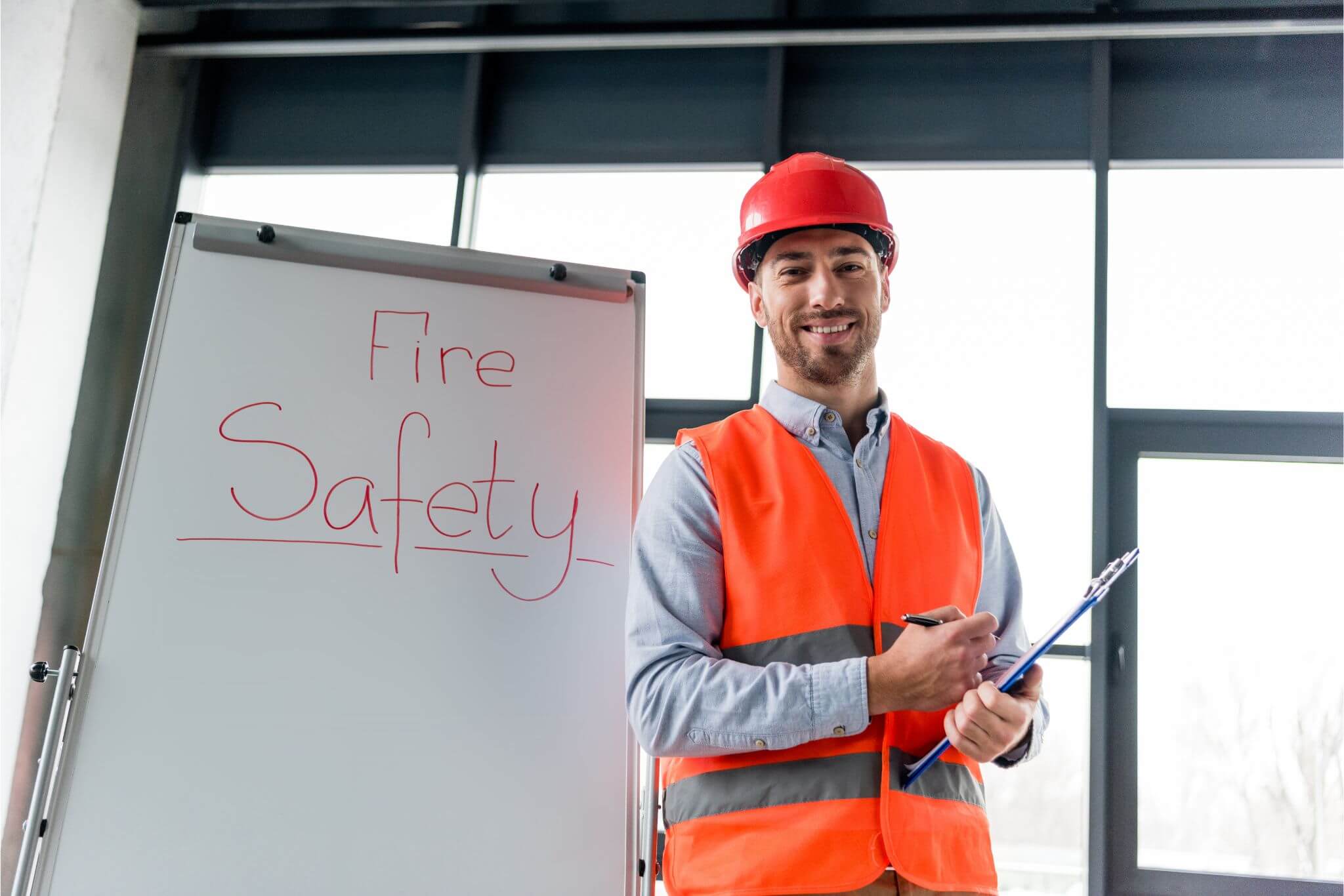Fire isn’t something that anybody ever expects to happen to them, but the truth is that fire can occur in properties, businesses and premises of all size and type.
A fire within a commercial, residential, industrial or public building can have serious consequences and result in significant damage, financial loss and of course serious injuries or even fatalities. This is why it is crucial to take the necessary steps to ensure that your property, the people who use it and the public are safe from the dangers of fire.
Whether you’re an employer, landlord or manager, as the person responsible for a business, commercial building or residential property, it is your legal duty to ensure that your premises are compliant with the relevant fire safety regulations and legislation. Failure to prioritise fire safety measures by not having a fire risk assessment in place, could result in serious penalties and even prosecution and imprisonment.
Understanding Fire Risk Assessments
- What is a fire risk assessment?
Fire risk assessments are an organised evaluation of a property designed to identify potential fire hazards and determine steps that can be taken to help reduce or eliminate them. This systematic, methodical and thorough assessment of the premises reviews not just the building itself, but its contents, layout and people to help ascertain how safe it is.
Fire risk assessments are crucial for both businesses and individuals because they can literally mean the difference between life and death by preventing fires from occurring and putting in place robust fire safety plans that prove vital in the event a fire does break out.
- What are the legal requirements regarding fire risk assessments?
Under the Regulatory Reform (Fire Safety) Order 2005, if you own, manage or operate a business in England or Wales then you must comply with fire safety law. This applies to almost all properties, buildings or structures other than individual private dwellings such as single residential homes, but flats, HMOs and maisonettes are covered in this order.
Fire risk assessments are a legal requirement as outlined in the fire safety guidance and failure to ensure that an adequate fire risk assessment or fire safety policy is in place can result in severe fines and prosecution.
- Who can carry out a fire risk assessment?
Fire risk assessments can be carried out by a competent person who has the sufficient knowledge, skills and experience to be able to effectively identify fire hazards, assess risks and provide guidance and recommendations on what needs to be done to reduce or remove the identified risks. This can be the ‘Responsible Person’ such as a landlord, managing agent, business owner, employer or person who controls the premises.
It is highly recommended however, that fire risk assessments be performed by a trained, experienced and professional fire safety specialist who can ensure that your fire risk assessments are completed to the best possible standard and that the property is safe and compliant.
Conducting a Fire Risk Assessment
There are a number of steps to go through when conducting a fire risk assessment. Here we take a look at what those steps are and provide some helpful information, guidance and advice on what is involved.
- Identifying Fire Hazards
The first step in any fire risk assessment is to identify potential fire hazards by walking through and physically inspecting the property. These hazards can vary depending on the type of premises, so we have included some examples below.
General fire hazards
These are commonly found in all types of properties and include things like;
- Blocked or obstructed fire exits and escape routes
- Smoking
- Naked flames
- Sources of oxygen such as natural air flow
Offices
- Overloaded power sources, plug sockets, extension cables and equipment
- Defective electrical fittings
- Papers, cardboard and combustible materials
- Clutter
- Portable heaters
HMO’s
- Cooking equipment
- Boilers
- Matches, lighters, candles
- Defective extension leads, adaptors, chargers etc
How to Identify Potential Fire Hazards
When it comes to hazard identification, there are some things you can do;
- Does it increase the chance of fire occurring?
- Could it catch fire / burn?
- Does it generate / spark heat?
- Think about what could go wrong
- Who is at risk?
- How people could get hurt
- Speak to residents / employees and see if they are aware of any fire hazards
Assessing Fire Risks and Hazards
Once you have identified potential fire hazards, you need to assess and evaluate each one taking into consideration;
- What is the hazard?
- How would you classify the risk? Low, medium or high risk?
- What are the potential consequences of that risk for the building structure and occupants? Slight harm, moderate harm or extreme harm?
- Using these classifications, you can find out the risk rating for each hazard which will help to determine the action level and timeframes that need to be met. This will allow you to effectively prioritise any changes, work, actions or follow ups that need to be carried out.
Implementing Fire Safety Measures
When you have identified what needs to be done and where, practical measures will need to be taken to ensure that the risks and hazards are decreased or eliminated.
- Reducing or removing risks and hazards
Once a fire risk or hazard has been identified, categorised and prioritised then steps can be taken to implement the necessary fire safety measures needed to help mitigate risks. Here are some examples of the types of changes that can be made;
- Remove piles of waste, paper, cardboard or things that could catch fire
- Conduct PACT testing on all electrical appliances
- Replace highly flammable material with alternatives
- Implement no smoking policy
- Upgrade fire alarm system
- Improve fire safety signage
- Appoint fire wardens
- Replace or repair any faulty wiring or equipment
Fire Safety Tools and Equipment
An important element of fire safety for any property is the installation, maintenance and training for key firefighting tools and equipment which can be used to help detect, suppress and control the spread of fire. Some of the key fire safety equipment commonly used includes;
- Fire alarms and smoke detectors
- Fire extinguishers
- Fire doors
- Fire sprinklers
It is not enough to merely have these installed, but they must be regularly checked and inspected in order to ensure they are in top working order.
- Evacuation Plans and Fire Drills
An effective Fire Emergency Evacuation Plan (FEEP) is an important aspect of fire safety that helps to explain what actions need to be taken in the event of a fire. This benefits those who work or live on the premises so that they know what to do when an alarm sounds. An FEEP should contain things like;
- Actions to take if a fire is discovered
- Fire evacuation strategy
- Actions upon hearing the fire alarm
- Calling the fire brigade
- Identifying escape routes
- Duties of fire wardens / marshals
- Assembly points and roll call
- Firefighting equipment provided
- Personal Emergency Evacuation Plan
- Liaising with emergency services
Carrying out regular fire drills is also important, and the results should be documented and kept as part of your fire safety and evacuation plan. Not only do they help to ensure that employees, residents, customers and visitors understand what they should do if there is a fire but allows you to test how effective your evacuation plan is and if there are areas that require improvement.
Maintaining Fire Safety
Doing a risk assessment once does not mean that it can be forgotten about for years, they must be regularly reviewed and updated in order to stay compliant, ensure that the fire safety measures put in place are still suitable and identify any new or additional risks.
- Evacuation Plans and Fire Drills
It is usually recommended that fire risk assessments be reviewed every 12 months or so, but it may need to be more often for high-risk premises or in situations where;
- The property has undergone structural changes
- The day-to-day operations have changed
- The number of people who use the property has increased significantly
- There has been a change of use for the property
- There has been a change in the contents stored on site, such as increased stock levels or dangerous chemicals
Staff Training and Awareness
A key part of maintaining fire safety will be to ensure that the appropriate staff or individuals receive training or are retrained or refreshed about the fire safety protocols. This can include things such as;
- How to prevent fires
- What to do in the event of a fire
- Fire safety features installed on premises (such as fire doors)
- Information about fire safety measures
- People to consider such as visitors, guests, contractors etc
How to create a positive fire safety culture
In all settings and environments, if you want your fire safety strategy to be sustainable then you need to make sure that everybody who uses the property takes it seriously and plays a role in keeping the building safe from fire. Here are some helpful tips on what landlords, employers and business owners can do to help create a positive fire safety culture.
- Commitment must be demonstrated first from the key leadership roles who must lead by example with their commitment to fire safety.
- Involvement is essential as tenants or employees are the key to the fire safety culture. Be sure to ask for their input and hear what they have to say, encourage their participation with safety initiatives and provide opportunities for meetings, discussions, teams or committees regarding fire safety.
- Communication is key and clear, open communication can help to foster an environment of positivity where staff or occupants feel like they can easily report and concerns, hazards or suggestions.
- Training should be offered regularly so that employees or residents can be equipped with the skills and knowledge they need to work or live on the premises safely.

